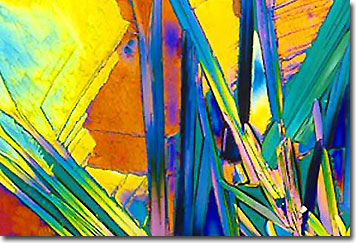Loes Modderman
Acetylsalicylic Acid-Hydroquinone Mixture
Both playing a role in the pharmaceutical industry, acetylsalicylic acid and hydroquinone are pictured here in a colorful crystal medley. Known by millions as aspirin, acetylsalicylic acid has been effective in the over-the-counter treatment of arthritis, headaches, cold and flu symptoms, and most recently, as a prophylactic fighting stroke and heart attacks. Originally extracted by the ancient Greeks in a related derivative from willows, biochemists at the Bayer Corporation synthesized and marketed acetylsalicylic acid and added a buffered outer layer to protect sensitive throat and stomach linings from irritation and potential hemorrhage. Hydroquinone, in contrast, has much more limited use in pharmaceuticals and cosmetics, and is potentially a carcinogen. It has been detected in analyses of second-hand cigarette smoke and is known to be a skin and respiratory irritant.

As an analgesic and antipyretic, acetylsalicylic acid, when taken in doses typically of 500 to 1000 milligrams, helps relieve pain and fevers. Based on Hippocrates' description of using willow bark bitter extract (actually salicylic acid) 2,500 years ago, doctors have prescribed these plant and synthesized derivatives for wide spectrum of ailments. However, it was not until 1971 when biochemist Sir John R. Vane described the mechanism of action, did anyone know how these compounds functioned. Acetylsalicylic acid inhibits the synthesis of prostaglandins, which activate and increase states of pain awareness. Further medical research demonstrated that aspirin prevented prostaglandin synthesis in blood platelets, thereby slowing or preventing clotting. With this in mind, doctors and pharmaceutical companies prescribe aspirin as both prophylactic and therapeutic treatments for heart attacks and strokes.
Having several alternative names including hydroquinol, quinol, p-benzenediol, p-hydroxyphenol, and 1,4-dihydroxybenzene, 1,4-benzenediol, hydroquinone forms an off-white powder or white, needle-like odorless crystals that melt at about 175 degrees Celsius. Highly water-soluble and both air and light sensitive, hydroquinone is only stable when properly stored. Most likely a carcinogen, this chemical substance is a severe skin, respiratory, and eye irritant and may be harmful if inhaled or ingested. Ironically, hydroquinone is a featured component in non-prescription skin products as a bleaching agent that decreases pigmentation spots associated with aging. The skin disease vitiligo, a disfiguring ailment reportedly inflicting pop-star Michael Jackson, is often treated with a 20 percent hydroquinone skin cream, which removes the normal skin pigment so that it better matches the depigmented patches.
International industrial manufacturing of hydroquinone has declined worldwide by 12.5 percent from 1979 to 1992, in part because of health scares. In addition to use in the cosmetic, hair dye, and pharmaceutical industries, hydroquinone is used extensively as a reducing agent, as a photographic developer, an antioxidant for industrial chemical reactions, a stabilizer or anti-polymerization agent, and as a chemical intermediate or stock reagent for the production of other antioxidants, agrochemicals, polymers, and anti-ozone agents. When not synthesized in a chemical factory, hydroquinone occurs naturally in plants and animals and products derived from them such as wheat germ, brewed coffee, and some berry-based brewed teas. Because of its chemical and physical nature, when improperly disposed of, hydroquinone significantly negatively affects aquatic ecosystems as a strong toxicant. However, because of its light and air instability properties, coupled with biological decomposition, the aromatic chemical does degrade relatively quickly when released into the environment. Interestingly, hydroquinone is measured in concentrations of 110 to 300 micrograms per cigarette in second-hand smoke. Despite medical research pointing towards human health and environmental risks, hydroquinone is still manufactured and utilized widely, with larger concentrations and dose exposures occurring outside the United States.
BACK TO LOES MODDERMAN GALLERY
